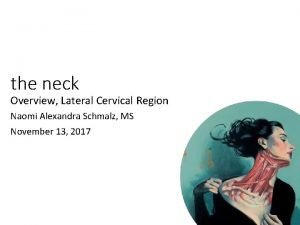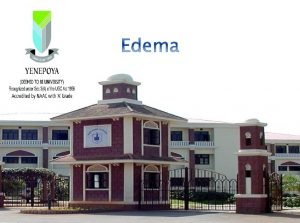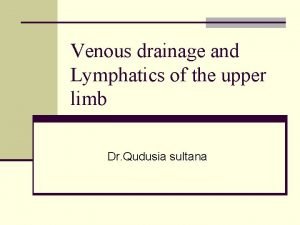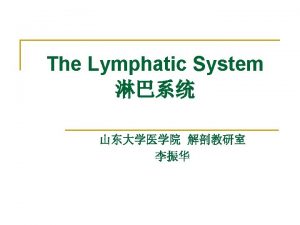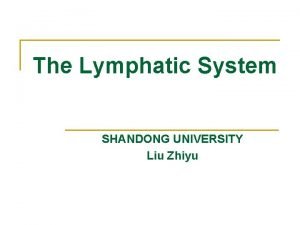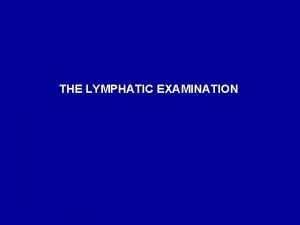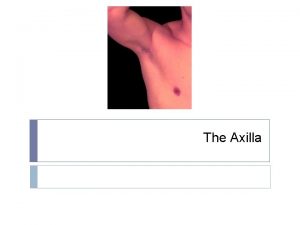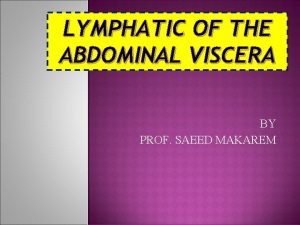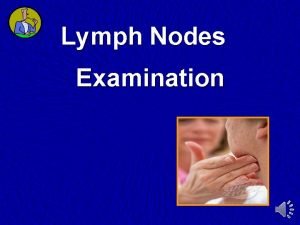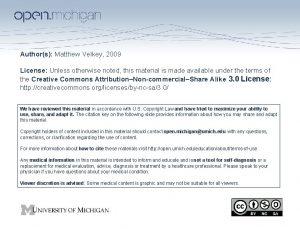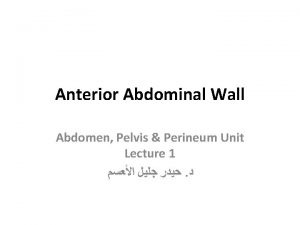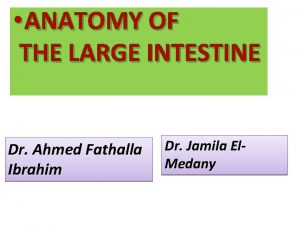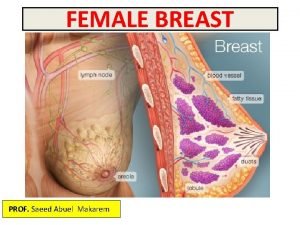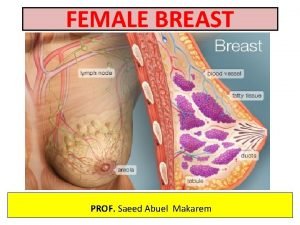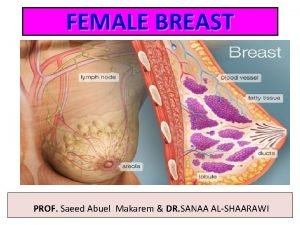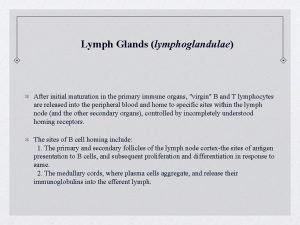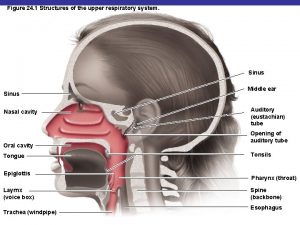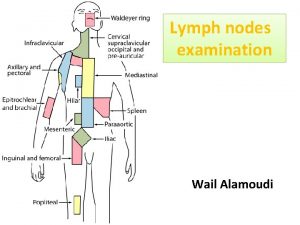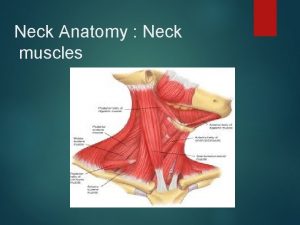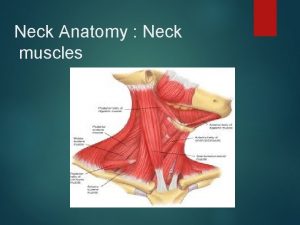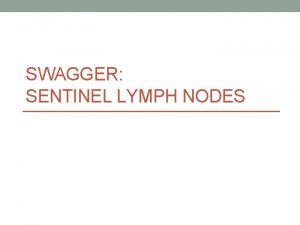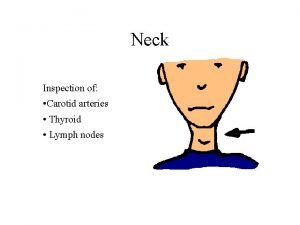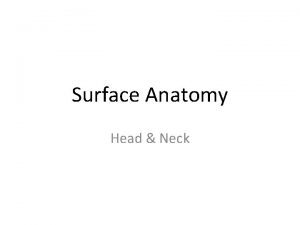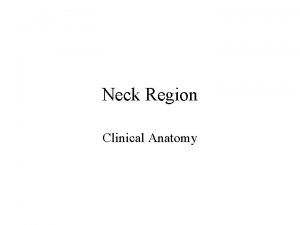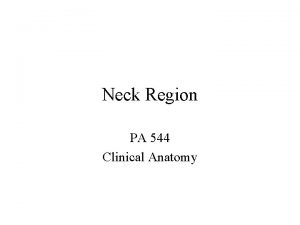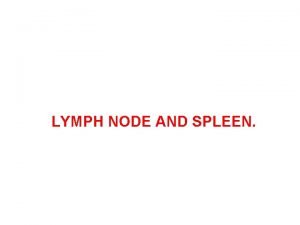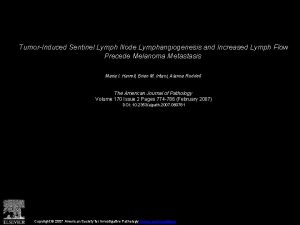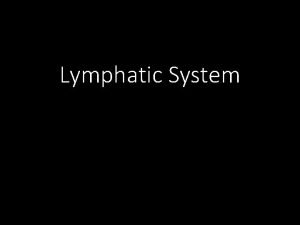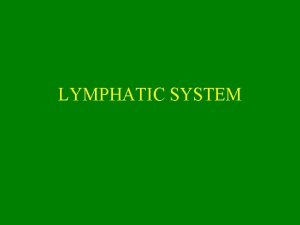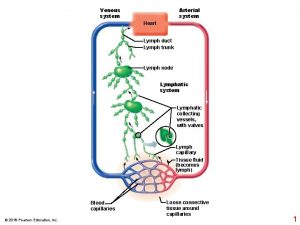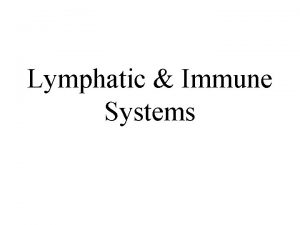ANATOMY OF LYMPH NODES OF HEAD AND NECK




























- Slides: 28


ANATOMY OF LYMPH NODES OF HEAD AND NECK Presented by : - Dr. Mukesh Singla

Lymphatic Drainage Of Head and Neck • Lymph nodes acts as a barrier against disease. • They are soft non palpable structure • Draining infected , inflamed or area involved in carcinomatous changes will cause the nodes to become swollen , hard , painful and palpable • They prevent disease from reaching major lymphatic channels • Position of nodes denotes general location of infection

Lymphatic Drainage Of Head and Neck Lymph nodes in the head and neck are arranged in A. Two horizontal rings and B. Two vertical chains on either side of the neck.

Lymphatic Drainage Of Head and Neck A. Two horizontal rings a) Outer superficial ring (pericervical ring. ) at junction of head and neck consists of • Occipital • Retro-auricular • preauricular (parotid) • submandibular • submental nodes


S. No Nodes Location 1 Occipital (2 -4) Superior nuchal line between sternocleidomastoid and trapezius 2 Mastoid (1 -3), or Retroauricular Superficial to sternocleidomastoid insertion 3 Preauricular (2 -3)parotid Anterior to ear over parotid fascia

S. NO Nodes Location 4 Parotid (up to 10 or About parotid gland more) and under parotid fascia Deep to parotid gland 5 Submental (2 -3) Submental triangle 6 Submandibular (3 -6) triangle adjacent to submandibular gland

Few Outlying Nodes Facial Superficial(up to 12) Distributed along Maxillary course of facial Buccal artery and vein Mandibular Deep Distributed along course of maxillary artery lateral to lateral pterygoid muscle Skin and mucous membranes of eyelids, nose, cheek Submandibular nodes Temporal and infratemporal fossa Nasal pharynx Superior deep cervical lymph nodes


Lymphatic Drainage Of Head and Neck A. Two horizontal rings b) Inner deep ring is formed by clumps of mucosa associated lymphoid tissue (MALT) located primarily in the naso- and oro-pharynx (Waldeyer's ring).

Waldeyer's tonsillar ring, consist of a) Unpaired pharyngeal tonsil in the roof of the pharynx, b) Paired palatine tonsils and c) Lingual tonsils scattered in the root of the tongue.

Superficial and deep vertical Chains of cervical nodes a) Superficial Vertical Chain I. Along external Jugular vein-called superficial cervical LN II. Along anterior Jugular vein- called anterior cervical LN

Superficial Vertical Chain i. Along external Jugular vein-called superficial cervical LN ii. Along anterior Jugular vein- called anterior cervical LN


Deep vertical chain consists of superior and inferior groups of deep cervical nodes related to the carotid sheath

Deep cervical glands Numerous and of large size: Form a chain along the carotid sheath, lying by the side of the pharynx, esophagus, and trachea, and extending from the base of the skull to the root of the neck.

Deep cervical glands They are usually described in two groups: (1) Superior deep cervical glands lying under the Sternocleidomastoid in close relation with the internal jugular vein, some of the glands lying in front of and others behind the vessel; Jugulodigastric LN- Part of superior deep cervical group of LN at Junction of internal jugular vein and posterior digastric muscle

Deep cervical glands They are usually described in two groups: (2) Inferior deep cervical glands may extend beyond the posterior margin of the Sternocleidomastoideus into the supraclavicular triangle, where they are closely related to the brachial plexus and subclavian vein. Jugulo-omohyoid - Above junction of internal jugular vein and omohyoid muscle

Few outlying LN Accessory (2 -6) Along accessory nerve in posterior triangle Occipital nodes Mastoid nodes Lateral neck and shoulder Transverse cervical nodes Transverse cervical (1 -10) Along transverse cervical blood vessels at level of clavicle Accessory nodes Apical axillary nodes Lateral neck Anterior thoracic wall Jugular trunk or directly into thoracic duct or right lymphatic duct or independently into junction of internal jugular vein and subclavian vein


All lymph vessels of the head and neck drain into the inferior deep cervical nodes, either directly from the tissues or indirectly via nodes in outlying groups.

Paravisceral deep nodes • Retropharyngeal(lie in the buccopharyngeal fascia, behind the upper part of the pharynx ) • Infrahyoid (Ant. to thyrohyoid membrane ) • Prelaryngeal( On conus elasticus and cricovocal membrane) • Pretracheal(Ant to trachea) • Paratracheal(Along RLN) • Subclavian(Subclavian triangle)



Deep vertical chain receive in addition to direct area of drainage - All efferent from pericervical ring - Efferents from superficial cervical nodes - Efferents from other paravisceral deep nodes-retropharyngeal, infrahyoid, prelaryngeal, pretracheal, paratracheal, subclavian

Final drainage of lymph All lymph from head and neck finally drain to ipsilateral lower deep cervical LN- Terminal group Efferent- Jugular lymph trunk- terminate at or near jugulosubclavian venous junction On left side usually joins the thoracic duct on the right side either joins the right lymphatic duct or empties independently at the junction of the IJV and subclavian vein

 What is ansa cervicalis
What is ansa cervicalis Lymph tends to stall inside lymph nodes. this is due to:
Lymph tends to stall inside lymph nodes. this is due to: Lymph tends to stall inside lymph nodes
Lymph tends to stall inside lymph nodes Are there lymph nodes in lower legs
Are there lymph nodes in lower legs Foot lymph nodes
Foot lymph nodes Parptid
Parptid Venous drainage of the upper limb
Venous drainage of the upper limb Lymphatic upper limb
Lymphatic upper limb Left lymphatic duct
Left lymphatic duct Axillary lymph nodes drainage
Axillary lymph nodes drainage Delphian node
Delphian node Lymph nodes: “filters of the blood”
Lymph nodes: “filters of the blood” Lymph nodes: “filters of the blood”
Lymph nodes: “filters of the blood” Axillary muscles
Axillary muscles Superior deep cervical lymph nodes drainage
Superior deep cervical lymph nodes drainage Interior trunk
Interior trunk Shotty lymph nodes
Shotty lymph nodes Lymph nodes function
Lymph nodes function Scarpa's fascia
Scarpa's fascia Large intestine characteristics
Large intestine characteristics Gluteal ligaments
Gluteal ligaments Ophthalmic artery
Ophthalmic artery Breast vascular supply
Breast vascular supply 5 groups of axillary lymph nodes
5 groups of axillary lymph nodes 5 groups of axillary lymph nodes
5 groups of axillary lymph nodes Submental lymph nodes location
Submental lymph nodes location Immune system lymph nodes
Immune system lymph nodes Supromedial
Supromedial Dimorphic fungus
Dimorphic fungus
